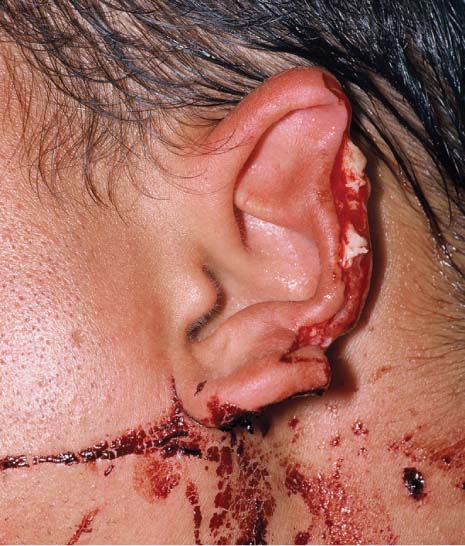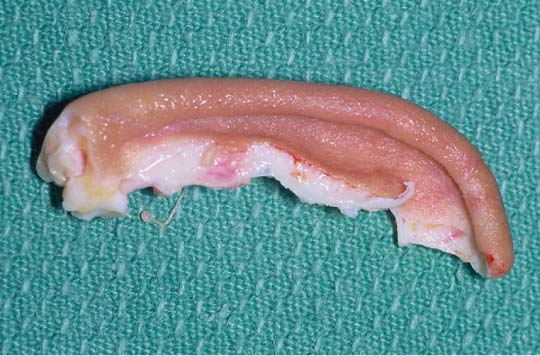80 A 32-year-old man involved in a motor vehicle accident goes to the emergency department 3 hours after injury for a partial avulsion of the left ear (Fig. 80.1). The amputated ear tissue was wrapped in a moist washcloth surrounded by ice (Fig. 80.2). The patient is alert and oriented ×4 and has no evidence of other serious injuries; his cervical spine was cleared. Fig. 80.1 Avulsed left ear 3 hours after injury. 1. With any head injury, a complete systemic trauma evaluation is required. The overall status of the patient must be evaluated and take priority (airway, breathing, circulation, cervical status, intracranial status). Only after these steps are stabilized, can obvious auricular injuries can be addressed. 2. Excessive cautery or clamping and ligation of vessels on the remaining auricle should be avoided to maximize revascularization of the reattached avulsed piece. 3. The auricle should be examined, irrigated copiously, and any foreign bodies removed. 4. The hearing, tympanic membrane, and external auditory canal should be examined. The function of the facial nerve should be checked. Based on the physical examination, the diagnosis is clear. If blood loss is a concern, a hemoglobin test can be done. Fig. 80.2 Avulsed skin cartilage segment comprising of the helix and scaphoid fossa. Traumatic partial auricular avulsion with most of the helix and scaphoid fossa of the auricle completely amputated To maximize salvage of the avulsed composite skin cartilage tissue before reaching the operating room, one should wrap it with an isotonic saline-soaked gauze contained in a plastic bag in an ice cooler with surrounding ice to decrease the tissue metabolic demands. Steroids are controversial but may be helpful. If the torn auricular tissue is still attached to the ear, the pedicle should be preserved because a very small pedicle can help the tissue survive owing to the dense vascular arcade of the auricle. Many methods to preserve auricular cartilage have been described. Because the auricle tissue is completely avulsed, the following are possible treatment options: 1. Partial burying and fenestrating the cartilage with reattachment (Baudet principle) 2. Delayed staged reconstruction 3. Osseo-integrated alloplastic reconstruction 4. Microvascular anastomosis (not for this case, because the vessels of the avulsed piece are too small to anastomose)
Auricular Avulsion
History
Differential Diagnosis—Key Points
Test Interpretation
Diagnosis
Medical Management
Surgical Management
Stay updated, free articles. Join our Telegram channel

Full access? Get Clinical Tree




